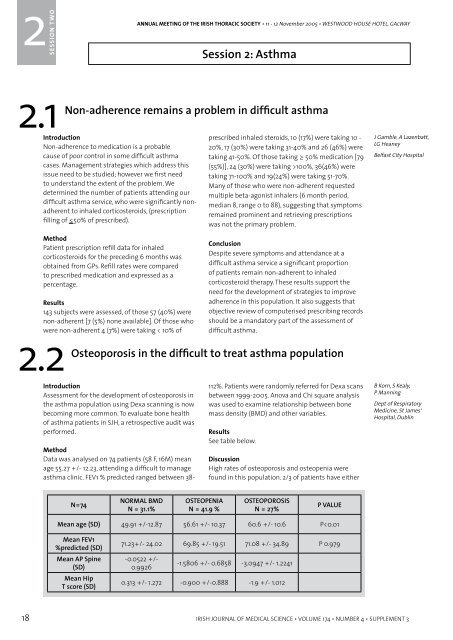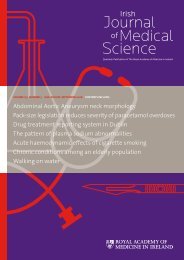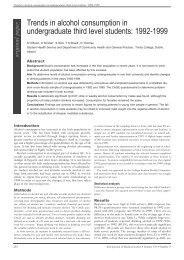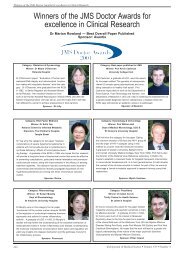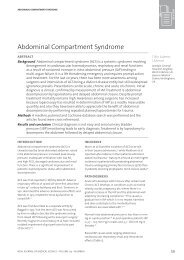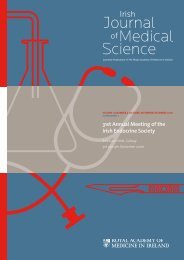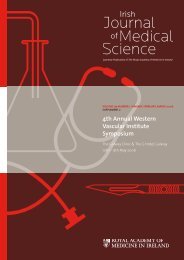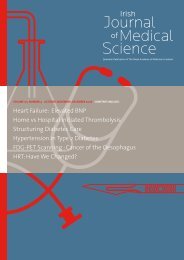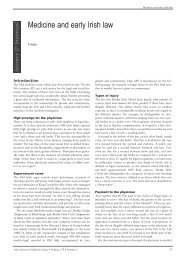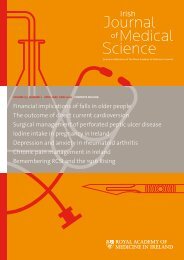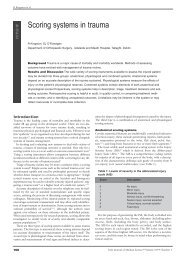Annual General Meeting of the Irish Thoracic Society - IJMS | Irish ...
Annual General Meeting of the Irish Thoracic Society - IJMS | Irish ...
Annual General Meeting of the Irish Thoracic Society - IJMS | Irish ...
Create successful ePaper yourself
Turn your PDF publications into a flip-book with our unique Google optimized e-Paper software.
21<br />
1<br />
SESSION TWO ONE<br />
ANNUAL MEETING OF THE IRISH THORACIC SOCIETY • 11 - 12 November 2005 • WESTWOOD HOUSE HOTEL, GALWAY<br />
Session 2: Asthma<br />
ANNUAL MEETING OF THE IRISH THORACIC SOCIETY • 11 - 12 November 2005 • WESTWOOD HOUSE HOTEL, GALWAY<br />
2<br />
SESSION<br />
SESSION TWO ONE<br />
2.1<br />
Introduction<br />
Non-adherence to medication is a probable<br />
cause <strong>of</strong> poor control in some difficult asthma<br />
cases. Management strategies which address this<br />
issue need to be studied; however we first need<br />
to understand <strong>the</strong> extent <strong>of</strong> <strong>the</strong> problem. We<br />
determined <strong>the</strong> number <strong>of</strong> patients attending our<br />
difficult asthma service, who were significantly nonadherent<br />
to inhaled corticosteroids, (prescription<br />
filling <strong>of</strong> ≤50% <strong>of</strong> prescribed).<br />
Non-adherence remains a problem in difficult asthma<br />
prescribed inhaled steroids, 10 (17%) were taking 10 -<br />
20%, 17 (30%) were taking 31-40% and 26 (46%) were<br />
taking 41-50%. Of those taking ≥ 50% medication [79<br />
(55%)], 24 (30%) were taking >100%, 36(46%) were<br />
taking 71-100% and 19(24%) were taking 51-70%.<br />
Many <strong>of</strong> those who were non-adherent requested<br />
multiple beta-agonist inhalers (6 month period,<br />
median 8, range 0 to 88), suggesting that symptoms<br />
remained prominent and retrieving prescriptions<br />
was not <strong>the</strong> primary problem.<br />
J Gamble, A Lazenbatt,<br />
LG Heaney<br />
Belfast City Hospital<br />
2.3<br />
osteoporosis or osteopenia. Patients with <strong>the</strong>se<br />
conditions tended to be older. However, this is a<br />
younger group than expected for <strong>the</strong>se conditions.<br />
Severity <strong>of</strong> asthma did not seem to affect level <strong>of</strong><br />
osteoporosis in both genders. Overall t - scores were<br />
lower in <strong>the</strong> spine compared to <strong>the</strong> hip.<br />
Conclusions<br />
This audit showed high incidence <strong>of</strong> reduced<br />
BMD in this group <strong>of</strong> asthma patients. Patients<br />
with more difficult to treat asthma need bone<br />
health assessments. Fur<strong>the</strong>r studies focussing on<br />
osteoporosis treatment, preventative strategies and<br />
evaluation <strong>of</strong> such measures are required.<br />
Fluticasone propionate/salmeterol in combination improves<br />
health outcomes and quality <strong>of</strong> life in children with poorly<br />
controlled asthma in Ireland<br />
Method<br />
Patient prescription refill data for inhaled<br />
corticosteroids for <strong>the</strong> preceding 6 months was<br />
obtained from GPs. Refill rates were compared<br />
to prescribed medication and expressed as a<br />
percentage.<br />
Results<br />
143 subjects were assessed, <strong>of</strong> those 57 (40%) were<br />
non-adherent [7 (5%) none available]. Of those who<br />
were non-adherent 4 (7%) were taking < 10% <strong>of</strong><br />
2.2<br />
Introduction<br />
Assessment for <strong>the</strong> development <strong>of</strong> osteoporosis in<br />
<strong>the</strong> asthma population using Dexa scanning is now<br />
becoming more common. To evaluate bone health<br />
<strong>of</strong> asthma patients in SJH, a retrospective audit was<br />
performed.<br />
Method<br />
Data was analysed on 74 patients (58 F, 16M) mean<br />
age 55.27 +/- 12.23, attending a difficult to manage<br />
asthma clinic. FEV1 % predicted ranged between 38-<br />
Conclusion<br />
Despite severe symptoms and attendance at a<br />
difficult asthma service a significant proportion<br />
<strong>of</strong> patients remain non-adherent to inhaled<br />
corticosteroid <strong>the</strong>rapy. These results support <strong>the</strong><br />
need for <strong>the</strong> development <strong>of</strong> strategies to improve<br />
adherence in this population. It also suggests that<br />
objective review <strong>of</strong> computerised prescribing records<br />
should be a mandatory part <strong>of</strong> <strong>the</strong> assessment <strong>of</strong><br />
difficult asthma.<br />
Osteoporosis in <strong>the</strong> difficult to treat asthma population<br />
N=74<br />
NORMAL BMD<br />
N = 31.1%<br />
OSTEOPENIA<br />
N = 41.9 %<br />
112%. Patients were randomly referred for Dexa scans<br />
between 1999-2005. Anova and Chi square analysis<br />
was used to examine relationship between bone<br />
mass density (BMD) and o<strong>the</strong>r variables.<br />
Results<br />
See table below.<br />
Discussion<br />
High rates <strong>of</strong> osteoporosis and osteopenia were<br />
found in this population. 2/3 <strong>of</strong> patients have ei<strong>the</strong>r<br />
OSTEOPOROSIS<br />
N = 27%<br />
P VALUE<br />
Mean age (SD) 49.91 +/-12.87 56.61 +/- 10.37 60.6 +/- 10.6 P=2 points<br />
between w0 and w16*. Mean day and night time<br />
symptoms scores improved by 1.5 points* and 1.6*<br />
points respectively between w0 and w16. Patients<br />
reported a mean <strong>of</strong> 3.9 more days per week without<br />
asthma symptoms and 4.6 fewer days using short<br />
acting βtwo agonist medication per week between<br />
w0 and w16*. Children missed 1.6 fewer school days<br />
per month between w0 and w16*. Carers missed a<br />
mean <strong>of</strong> 1.2 fewer days per month from work*. No<br />
treatment related adverse events were reported.<br />
Conclusions<br />
SFC significantly improved asthma symptoms,<br />
quality <strong>of</strong> life and daily activities <strong>of</strong> uncontrolled<br />
paediatric asthma patients and <strong>the</strong>ir families.<br />
* P


